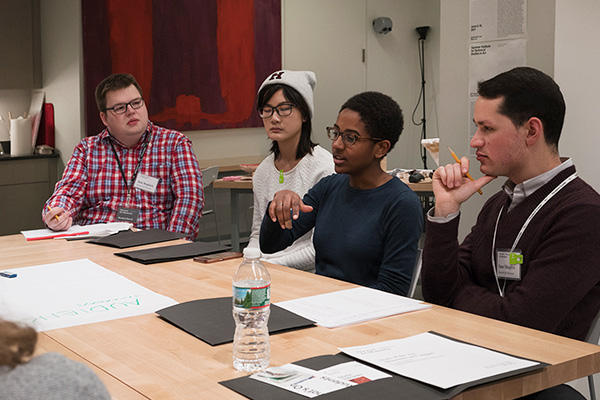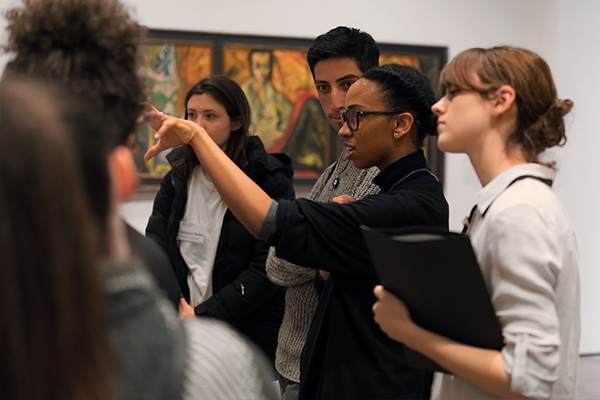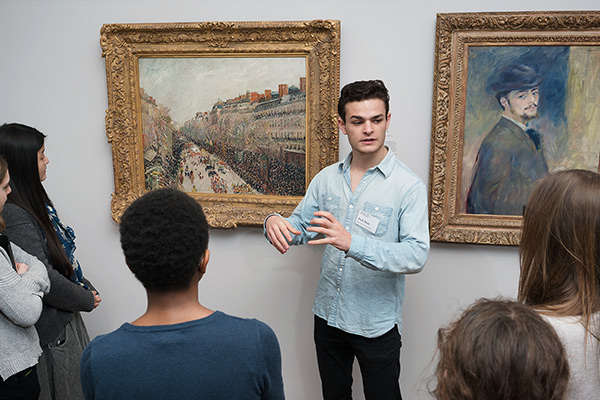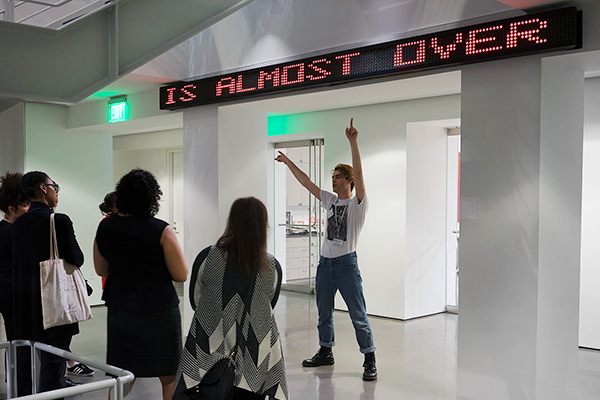Editor’s Note: The Harvard Art Museums recently hosted an inaugural conference for undergraduates involved with campus art museums in the greater Boston area. We asked Hyemi Park, a Harvard College senior and one of our student guides, to share details about the event and give us a glimpse into her experience as a participant.
“Hi, what museum do you represent?” was the most popular question asked over cookies and tea at the inaugural greater Boston undergraduate student conference, State of the Art: Museums on Campus. Held on April 1 at the Harvard Art Museums, the conference brought together approximately 50 students involved with the Davis Museum at Wellesley College, McMullen Museum of Art at Boston College, Rose Art Museum at Brandeis University, List Visual Arts Center at MIT, 808 Gallery at Boston University, Bakalar & Paine Galleries at Massachusetts College of Art and Design, and of course, our very own Harvard Art Museums community, including student guides and Student Board members. As a student guide, I attended the conference and even presented an object from my tour to fellow conference participants.
Developed by the museums’ Division of Academic and Public Programs with the input of Student Board members and student guides, the experience was intended to give local campus museum communities an opportunity to network, exchange stories, and share ideas about students’ relationships with their museums. I was especially excited to hear about the differences and similarities in our experiences and how these nuances shape our love for our respective art institutions.
The event kicked off in Menschel Hall with an introduction by Student Board member Rob Hopkirk ’18, along with welcome remarks from Martha Tedeschi, the Elizabeth and John Moors Cabot Director of the Harvard Art Museums, and David Odo, director of student programs.
An opening panel, moderated by student guide Ariana Chaivaranon ’18 and Student Board member William Lobkowicz ’18, featured panelists representing each of the participating institutions. The panelists reflected on what makes campus museums important, how they differ from other art institutions in Boston, and what efforts can be made to increase their visibility to a wide range of students.
It was interesting to hear about the diversity of programs offered by the museums and the various roles students play in them. At the Bakalar & Paine Galleries, for instance, student gallery attendants are trained as museum guards and educators, while at the Davis Museum, students work as visitor assistants. Student duties at campus museums range from organizing scavenger hunts, to developing programming, to making art memes for social media.
I also enjoyed hearing how students were helping their institutions better connect with campus communities. One of my favorite comments was made by Echo Zhuge, a student ambassador at the McMullen Museum of Art, who praised her museum’s Art After Dark student events. Echo said that the student-only access made those who attended the event feel special and welcome at the museums. The Harvard Art Museums’ own Student Late Night earlier this academic year was one of my favorite museum events, so I could not agree more with Echo’s point.
Following a brief break over refreshments, we returned to the museums so six of my fellow student guides and I could introduce our galleries to conference participants. Each of us presented one work of art from our regular tours. I showed an ancient Greek wine vessel that I feature in my tour about entertainment and leisure.
For the program’s next session, we broke into small groups led by Student Board members to consider topics regarding academic art museums and student engagement (including social media, audiences, careers, and post-graduation plans), responsibilities of museums, and students’ sense of connection with museums. I participated in a discussion of social media led by Harvard College senior and Student Board member Ritchey Howe. It’s a topic I am invested in, due to my role as a manager of Harvard Art Happens (along with student guide Isabella Beroutsos ’19), which is the social media handle for the Harvard Art Museums student community (look for us on Instagram and Facebook).
I found the social media session incredibly eye-opening and informative. Hearing about the work happening at other campus museums gave Isabella and me many ideas to test on our own accounts. We all agreed that our social media presence should be fun and accessible, serving as the bridge that encourages students to step into and engage with their museums.
The conference concluded back in Menschel Hall with closing remarks from student guide Samuel Shapiro ’18. Overall, it was an amazing way for like-minded students to share ideas based not only on their passion for art but also on their dedication to making it more accessible. Even though I will be graduating in May, I am so excited for future iterations of this conference and am grateful to have been a part of its inception.
Hyemi Park ’17 is concentrating in classics with a secondary in the history of art and architecture.







